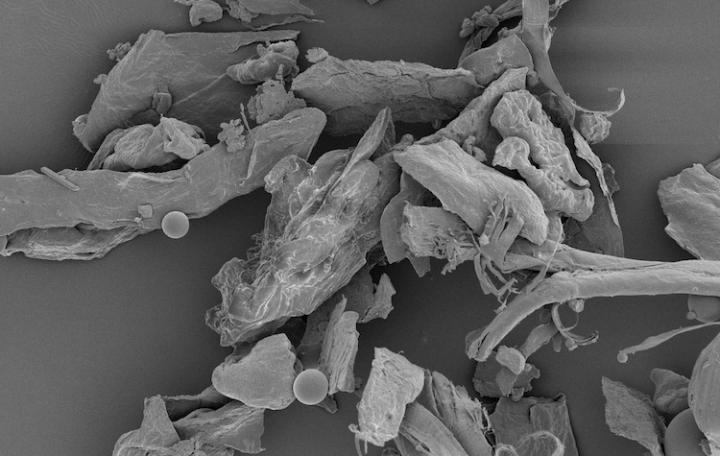Home sweet microbe: Dust in your house can predict geographic region, gender of occupants

This image shows household dust under a microscope. Credit: NIAID
The new findings, which were published today in the journal Proceedings of the Royal Society B, highlight the impressive amount of microbial diversity in the average household and the degree to which these organisms can tell a story about the homes they inhabit.
“Every day, we're surrounded by a vast array of organisms in our homes, most of which we can't see,” said Noah Fierer, an Associate Professor in the Department of Ecology and Evolutionary Biology at CU-Boulder and a co-author of the study. “We live in a microbial zoo, and this study was an attempt to catalog that diversity.”
The study examined roughly 1,200 homes across the continental U.S. Volunteers participating in the Wild Life of Our Homes citizen science project helped researchers collect indoor and outdoor dust samples at each site.
On average, each home contains more than 5,000 different species of bacteria and around 2,000 species of fungi. Fungal communities tend to be more predictive of a home's location while bacterial communities provide clues about the identity of its residents.
“Geography is the best predictor of fungi in your home,” said Fierer, who is also a research fellow at the Cooperative Institute for Research in Environmental Sciences (CIRES) at CU-Boulder. “The reason is that most fungi blow in from outdoors via soil and leaves,” he said, noting that a home in the upper Midwest, for instance, will harbor distinct fungi compared to a home in the Southeast.
When it comes to bacteria, however, where you live may be less important than whom you live with. From the dust samples, researchers could confidently predict which homes had pets such as cats or dogs and, to a slightly lesser extent, the gender ratio of the residents. Homes with only male occupants, for example, will have a different bacterial makeup than those with both male and female occupants.
“One of the key takeaways is that if you want to change what you breathe inside your house, you would either have to move very far away or change the people and the pets you live with,” said Albert Barbarán, a graduate researcher in CU-Boulder's Department of Ecology and Evolutionary Biology and lead author of the study.
The findings may have future implications for forensic investigations and allergen research.
The study was co-authored by Rob Dunn, Associate Professor of Biological Sciences at North Carolina State University (NCSU); Brian Reich, Associate Professor in the Department of Statistics at NCSU; Krishna Pacifici, Research Assistant Professor in the Department of Applied Ecology at NCSU; Eric Laber, Assistant Professor in the Department of Statistics at NCSU; Holly Menninger, Director of Public Science for the College of Sciences at NCSU; Shelly Miller, Professor in the Department of Mechanical Engineering at CU-Boulder; James Morton, a former graduate researcher in the Department of Interdisciplinary Qualitative Biology at CU-Boulder; and Jessica Henley and Jonathan Leff, both graduate researchers in the Department of Ecology and Evolutionary Biology at CU-Boulder.
The National Science Foundation provided funding for the research, with additional support from the A.P. Sloan Microbiology of the Built Environment Program and the Personal Genomes Project.
Media Contact
All latest news from the category: Life Sciences and Chemistry
Articles and reports from the Life Sciences and chemistry area deal with applied and basic research into modern biology, chemistry and human medicine.
Valuable information can be found on a range of life sciences fields including bacteriology, biochemistry, bionics, bioinformatics, biophysics, biotechnology, genetics, geobotany, human biology, marine biology, microbiology, molecular biology, cellular biology, zoology, bioinorganic chemistry, microchemistry and environmental chemistry.
Newest articles

New organoid with all key pancreas cells
Researchers from the Organoid group (previously Clevers group) at the Hubrecht Institute have developed a new organoid that mimics the human fetal pancreas, offering a clearer view of its early development….

Unlocking the potential of nickel
New study reveals how to use single atoms to turn CO2 into valuable chemical resources. Nickel and nitrogen co-doped carbon (Ni-N-C) catalysts have shown exceptional performance in converting CO2 into…

‘Spooky action’ at a very short distance
Scientists map out quantum entanglement in protons. Particles streaming from collisions offer insight into dynamic interactions and collective behavior of quarks and gluons. Scientists at the U.S. Department of Energy’s…



